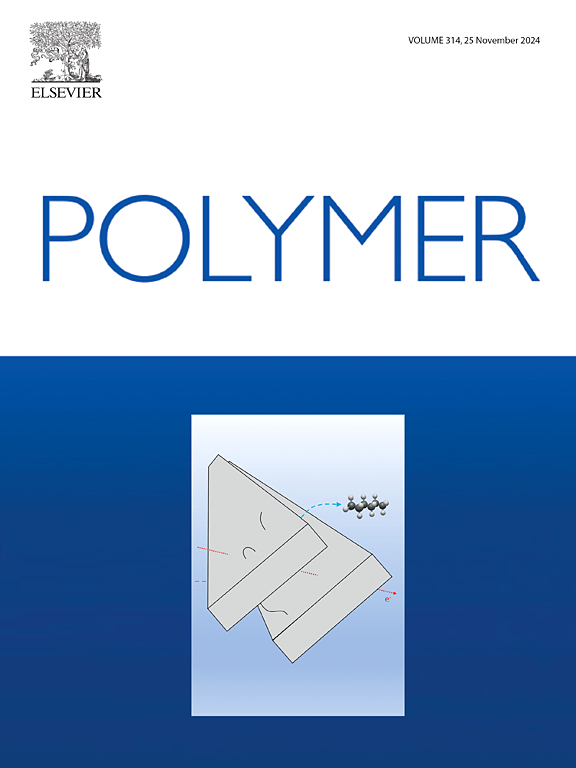Degradation behavior and aging mechanisms of silicone rubber under Ultraviolet–Thermal–Humidity Coupling in simulated tropical marine atmospheric environment
IF 4.1
2区 化学
Q2 POLYMER SCIENCE
引用次数: 0
Abstract
As a high-performance sealing material widely used in equipment, the degradation behavior and aging mechanism of silicone rubber have garnered significant attention under complex service environments. This study systematically investigates the degradation behavior and aging mechanisms of silicone rubber under simulated Ultraviolet(UV)–Thermal–Humidity (UTH) Coupling conditions in a tropical marine atmospheric environment. By establishing a conversion relationship between laboratory indoor radiation and outdoor UV radiation in the South China Sea, an accelerated aging test was designed. Comprehensive analyses of macroscopic physical properties, mechanical performance, and microstructural evolution reveal distinct phase characteristics of silicone rubber aging under coupling conditions. The early stage is dominated by surface cross-linking and initial oxidation induced by the synergistic effects of UV radiation and humidity. The intermediate stage is characterized by degradation reactions, leading to intensified crack propagation and structural reorganization. The late stage is governed by cross-linking reactions, resulting in densified internal structures. Compared to single-factor UV aging, degradation under coupling conditions penetrates deeper into the material, although the failure modes in both environments similarly transition from early-stage ductile fracture to late-stage brittle fracture. This study elucidates the dynamic relationship between the aging process and environmental factors, providing a theoretical foundation for aging analysis and residual life prediction of silicone rubber under complex coupling conditions. These findings may serve as a useful reference for optimizing the service performance of silicone rubber in marine atmospheric environments.


模拟热带海洋大气环境中紫外-热-湿耦合作用下硅橡胶的降解行为及老化机理
作为一种广泛应用于设备的高性能密封材料,硅橡胶在复杂使用环境下的降解行为和老化机理受到了广泛关注。本研究系统研究了热带海洋大气环境中硅橡胶在模拟紫外线-热湿耦合条件下的降解行为和老化机理。通过建立南海实验室室内辐射与室外紫外线辐射的转换关系,设计了加速老化试验。综合分析宏观物理性能、力学性能和微观组织演变,揭示了耦合条件下硅橡胶老化的明显相特征。早期以表面交联和紫外线辐射和湿度的协同作用引起的初始氧化为主。中间阶段以降解反应为特征,导致裂纹扩展和结构重组加剧。后期由交联反应控制,导致致密的内部结构。与单因素紫外线老化相比,耦合条件下的降解对材料的渗透更深,尽管两种环境下的破坏模式类似地从早期韧性断裂过渡到后期脆性断裂。本研究阐明了老化过程与环境因素之间的动态关系,为复杂耦合条件下硅橡胶的老化分析和剩余寿命预测提供了理论基础。研究结果可为优化硅橡胶在海洋大气环境中的使用性能提供有益的参考。
本文章由计算机程序翻译,如有差异,请以英文原文为准。
求助全文
约1分钟内获得全文
求助全文
来源期刊

Polymer
化学-高分子科学
CiteScore
7.90
自引率
8.70%
发文量
959
审稿时长
32 days
期刊介绍:
Polymer is an interdisciplinary journal dedicated to publishing innovative and significant advances in Polymer Physics, Chemistry and Technology. We welcome submissions on polymer hybrids, nanocomposites, characterisation and self-assembly. Polymer also publishes work on the technological application of polymers in energy and optoelectronics.
The main scope is covered but not limited to the following core areas:
Polymer Materials
Nanocomposites and hybrid nanomaterials
Polymer blends, films, fibres, networks and porous materials
Physical Characterization
Characterisation, modelling and simulation* of molecular and materials properties in bulk, solution, and thin films
Polymer Engineering
Advanced multiscale processing methods
Polymer Synthesis, Modification and Self-assembly
Including designer polymer architectures, mechanisms and kinetics, and supramolecular polymerization
Technological Applications
Polymers for energy generation and storage
Polymer membranes for separation technology
Polymers for opto- and microelectronics.
 求助内容:
求助内容: 应助结果提醒方式:
应助结果提醒方式:


